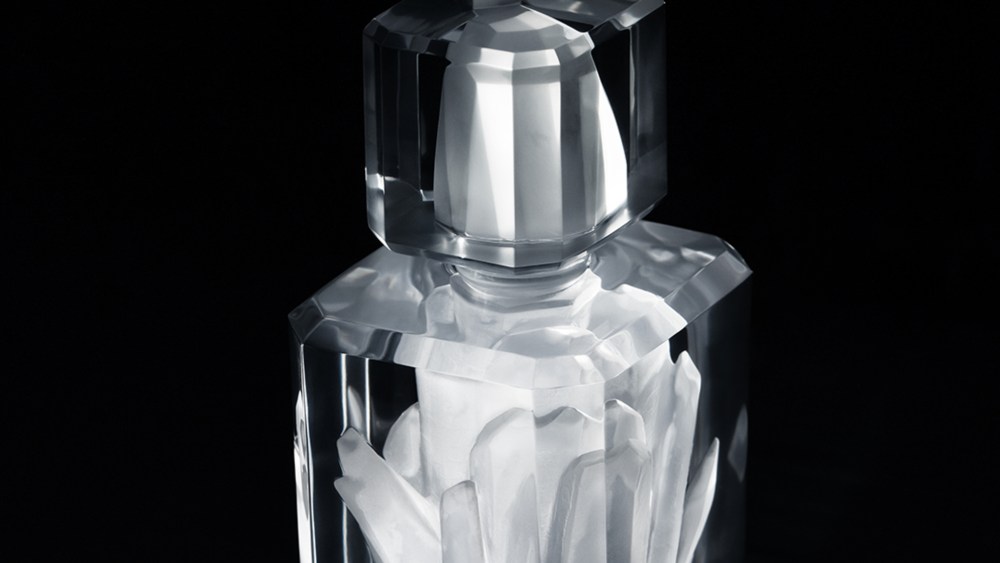MILAN — In the year of its 80th anniversary, Brioni during Milan Design Week will unveil a limited edition of 18 signed crystal flacons with Lalique, each housing a parfum essence.
Named Dualité, Crystal Edition perfume, the artistic and collector’s object was four years in the making, brought to life by Brioni’s design director Norbert Stumpfl and Lalique artistic and creative director Marc Larminaux. The Extrait de Parfum was created by master perfumer Michel Almairac.
The flacon’s octagonal prism is an homage to Brioni’s eight decades, and its smooth angular lines contrast with an eruption of crystal shards within it created through an ancient technique called lost-wax or cire perdue. It was revived for this project as the intricate and detailed sculptures within the flacon can only be crafted by using this technique. The silver hue of the fragrance enhances the contrast with the crystal.
You May Also Like
First explored by René Lalique around 1893, the complex cire perdue method has been passed down to Lalique’s master-glassmakers in their original workshop located in Wingen-sur-Moder, a village in the Alsace region of France.
“We really wanted to create something very special, because we are celebrating our 80th anniversary, and this is really a symbol of our craftsmanship, in the pursuit of excellence, which is very similar to our tailoring and I think with Lalique, we share the same codes,” said Stumpfl.

Lalique has been Brioni’s fragrance licensee since 2019 and it has developed four other scents for the Kering-owned brand.
“We are mesmerized by what’s possible with Lalique, and we have a very similar design aesthetic and vision, we are always trying to make something very pure and of exceptional luxury. In terms of the crystal, it’s so transparent that you can see all the workmanship that goes inside it. Also, I’m always looking for precious materials and rare techniques that human hands can make,” Stumpfl said.
The designer also sees “the shape of a shoulder” in the crystal bottle, “slim on the bottom, and it goes up to almost like a shoulder of a perfect suit.”
Stumpfl said Milan Design Week was “the perfect time” to unveil the project because of the centrality of the city for design during this period. “This is really more of an artistic sculpture,” he contended.
The crystal is housed in a pure white alabaster stone casing that can transform into a pedestal, reminiscent of a Roman column, creating an art installation, with the empty flacon weighing almost 6 kilos as the alabaster box. Hence the retail price of 40,000 euros.
“It’s a very difficult process to make this bottle, because of the lost wax process. It’s always kind of a miracle when we get a good piece out of the mold. We have to create the wax piece then we cover it with plaster and make it melt in the first furnace so that when the wax disappears, it’s lost, gone. And you have this plaster mold with an empty space left inside,” explained Larminaux.
The plaster is filled with the crystal, and the mold spends a bit more than a week in a closed furnace. “You have to be gentle with the temperatures, up and down slowly to avoid any thermal shock, hoping that the crystal has properly spread into the mold. You see how complex the shape is inside the bottle with this explosion of shards, so you have a big chance to get it wrong. Then you break the mold, and you just cross fingers, hoping that everything went the way it should, and that you don’t have fragilities like bubbles or what we call calcine, which means kind of tiny, little broken parts that you wouldn’t even notice, and that would break later on,” said Larminaux.
The stopper is also made in this way for continuity. Because of this treatment, filling the flacon properly is also a task.

The fragrance begins with an abstract ozonic accord, heightened by the bright, crisp bite of green apple. As the scent unfolds, a more delicate heart reveals the sweetness of violet blended with Ambroxan, adding a velvety, warm texture. Nestled within is the opulent and very rare iris butter — crafted through a seven-year process: three years of cultivation, three years of curing, and more than a year to extract the butter and process it. “We were looking for a very rare ingredient for a very unique scent,” said Stumpfl.
The aromatic presence of cedarwood is combined with moss while dry amber concludes the composition.
“I always love to keep all these techniques alive, and modernize them, showing them to the world. I think it’s really important. And for our 80th anniversary, we want to push further in this kind of slow, luxury direction,” said Stumpfl. “I think that’s what people really want to see nowadays, this authenticity of craft that you cannot fake. It’s years of experience of craftsmen who do this.”



